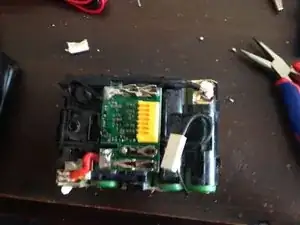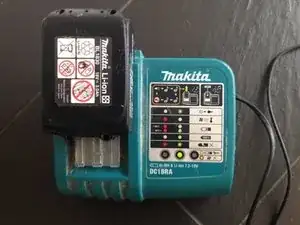Einleitung
-
-
Before we start with the dismantling, remember that even if your batteries do not work anymore they most likely still contain a significant amount of energy. Be careful in how you handle them and above all make sure you do not short them out.
-
So the first step is to get the cover off. This is held on by four T10 Anti Tamper screws, on newer models there may be a white Anti Tamper plug covering one of the screws. I have found that the easiest way to remove it is to drive in a small wood screw and pull it out with a pair of pliers.
-
So the first step is to get the cover off. This is held on by four T10 Anti Tamper screws, on newer models there may be a white Anti Tamper plug covering one of the screws. I have found that the easiest way to remove it is to drive in a small wood screw and pull it out with a pair of pliers.
-
If on opening you seen any visibly damaged cells you are going to have to replace them which is outside of the scope of this write up.
-
-
-
I had four failed batteries, and checked the voltages of the batteries and cell pairs individually. I found the following:
-
attery One: Fails to charge with a over temperature alert. Also the plastic at the side of the release button has bubbled. It is showing 7.99v across the whole battery which is way to low and 0.04v, 0v, 3.96v, 0.04v and 3.97v across each of the cell pairs respectively. Upon opening up the battery there is obvious damage to the second pair of cells.
-
Battery Two: Fails to charge with classic red / green flashing lights. It is 12.84v across the battery and 3.2v, 0v, 3.22v, 3.22v & 3.21v across each of the cell pairs respectively.
-
Battery Three: Fails to charge with classic red / green flashing lights. It is 15.54v across the battery and 0v, 3.89v, 3.89v, 3.89v & 3.89v across each of the cell pairs respectively.
-
Battery Four: Fails to charge with classic red / green flashing lights. It is 18.15v across the battery and 3.62v, 3.63v,3.6, 3.63 &3.62v across each of the cell pairs respectively.
-
By way of comparison a known good battery seems to measure around 20v when freshly charged.
-
-
-
The control board came with ok instructions on how to fit but they don't explain everything, this may be because it can be used with all of the models of 18v LXT battery Makita have made. Providing you have a bit of common sense you should be ok.
-
So apart from the soldering you might expect you also have to cut away a lot plastic and that's assuming you are lucky like me and don't need to replace any cells. If you do spot welding to the cells is the best way to go, as if you solder you risk overheating.
-
As I had previously got the battery pack out of the case the first thing to do was remove the existing pcb and cut away the plastic pcb support etc as per the instruction. I opted to cut the nickel contacts instead of desoldering. Fitting the pcb and soldering the wires to the contacts was simple although I had to break out my larger soldering.
-
-
-
Next came the moment of truth, I put the battery on a charger and it charged. I then fully discharged the battery and once again recharged the battery and that also worked. Eight month on the battery is still preforming perfectly.
-
To reassemble your device, follow these instructions in reverse order.
3 Kommentare
Title is Makita 18v LXT Lithium-ion Battery Charger Repair
Article is Makita 18v LXT Lithium-ion Battery Repair
Not at all helpful when I am fixing a charger
Ralph -
Agree the post does nothing for the individuals whom are looking for a solution to common charger repairs.
I have a few Makita 18RC chargers so perhaps I can share some findings when I can run some testing.
Whereas the BMS board is an aftermarket Battery fix when you have burnt battery contacts they are a nice retrofit solution but
I honestly find you can retrofit the old BMS with electrical cable lead instead of tie bar strip that I find to a complete pain if restoring the battery pack, or repairing opens on the battery cell tie straps.
Barry -
does anyone know how to test the battery cells and the control board to see where the problem is ?



